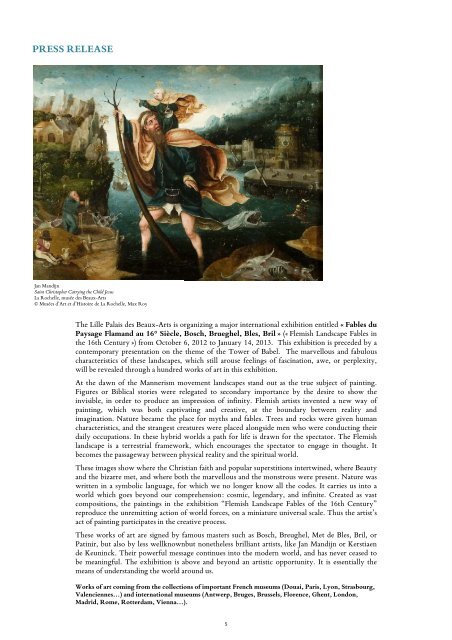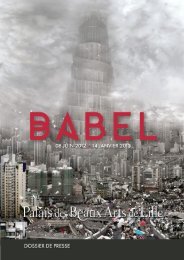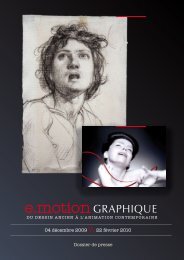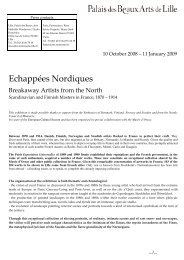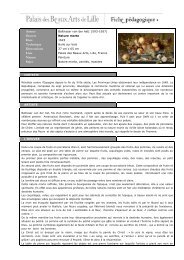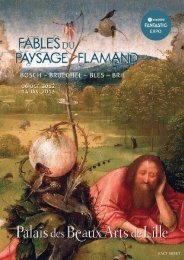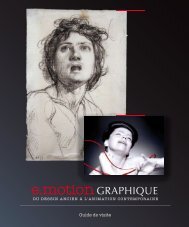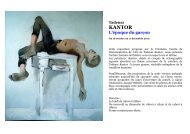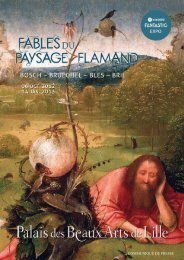PRESS KIT - Palais des Beaux Arts de Lille
PRESS KIT - Palais des Beaux Arts de Lille
PRESS KIT - Palais des Beaux Arts de Lille
Create successful ePaper yourself
Turn your PDF publications into a flip-book with our unique Google optimized e-Paper software.
<strong>PRESS</strong> RELEASE<br />
Jan Mandijn<br />
Saint Christopher Carrying the Child Jesus<br />
La Rochelle, musée <strong><strong>de</strong>s</strong> <strong>Beaux</strong>-<strong>Arts</strong><br />
© Musées d’Art et d’Histoire <strong>de</strong> La Rochelle, Max Roy<br />
The <strong>Lille</strong> <strong>Palais</strong> <strong><strong>de</strong>s</strong> <strong>Beaux</strong>-<strong>Arts</strong> is organizing a major international exhibition entitled « Fables du<br />
Paysage Flamand au 16° Siècle, Bosch, Brueghel, Bles, Bril » (« Flemish Landscape Fables in<br />
the 16th Century ») from October 6, 2012 to January 14, 2013. This exhibition is prece<strong>de</strong>d by a<br />
contemporary presentation on the theme of the Tower of Babel. The marvellous and fabulous<br />
characteristics of these landscapes, which still arouse feelings of fascination, awe, or perplexity,<br />
will be revealed through a hundred works of art in this exhibition.<br />
At the dawn of the Mannerism movement landscapes stand out as the true subject of painting.<br />
Figures or Biblical stories were relegated to secondary importance by the <strong><strong>de</strong>s</strong>ire to show the<br />
invisible, in or<strong>de</strong>r to produce an impression of infinity. Flemish artists invented a new way of<br />
painting, which was both captivating and creative, at the boundary between reality and<br />
imagination. Nature became the place for myths and fables. Trees and rocks were given human<br />
characteristics, and the strangest creatures were placed alongsi<strong>de</strong> men who were conducting their<br />
daily occupations. In these hybrid worlds a path for life is drawn for the spectator. The Flemish<br />
landscape is a terrestrial framework, which encourages the spectator to engage in thought. It<br />
becomes the passageway between physical reality and the spiritual world.<br />
These images show where the Christian faith and popular superstitions intertwined, where Beauty<br />
and the bizarre met, and where both the marvellous and the monstrous were present. Nature was<br />
written in a symbolic language, for which we no longer know all the co<strong><strong>de</strong>s</strong>. It carries us into a<br />
world which goes beyond our comprehension: cosmic, legendary, and infinite. Created as vast<br />
compositions, the paintings in the exhibition “Flemish Landscape Fables of the 16th Century”<br />
reproduce the unremitting action of world forces, on a miniature universal scale. Thus the artist’s<br />
act of painting participates in the creative process.<br />
These works of art are signed by famous masters such as Bosch, Breughel, Met <strong>de</strong> Bles, Bril, or<br />
Patinir, but also by less wellknownbut nonetheless brilliant artists, like Jan Mandijn or Kerstiaen<br />
<strong>de</strong> Keuninck. Their powerful message continues into the mo<strong>de</strong>rn world, and has never ceased to<br />
be meaningful. The exhibition is above and beyond an artistic opportunity. It is essentially the<br />
means of un<strong>de</strong>rstanding the world around us.<br />
Works of art coming from the collections of important French museums (Douai, Paris, Lyon, Strasbourg,<br />
Valenciennes…) and international museums (Antwerp, Bruges, Brussels, Florence, Ghent, London,<br />
Madrid, Rome, Rotterdam, Vienna…).<br />
5


